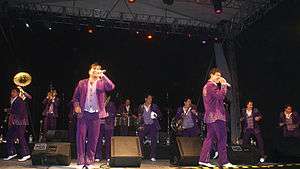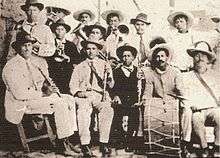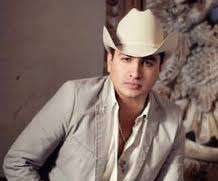Banda (music)

Banda is a brass-based form of traditional Mexican music. Bandas play a wide variety of songs, including rancheras, corridos, cumbias, baladas, and boleros. Bands are most widely known for their rancheras, but they also play modern Mexican pop, rock, and cumbias. Most Banda music is very clearly a dialect of polka and will seem familiar and appealing to fans of polka or traditional German and Polish music.
The late Jenni Rivera years' long career included such honors as 20 million albums sold, making her the highest earning banda singer of all time. She is also responsible for bringing a female perspective to what had historically been a male-dominated genre.[1][2][3] La Banda El Recodo, Banda Machos, Banda Maguey, La Arrolladora Banda El Limón, La Original Banda El Limón, Banda Sinaloense MS De Serigo Lizarraga, La Septima Banda, Banda Cuisillos, Banda Jerez, Banda Los Recoditos and La Adicitva Banda San Jose De Mesillas are some of the most famous banda groups. Despite banda being a male-dominated genre, there are a few female soloist banda-singers such as Ana Gabriel, Carmen Jara, Shaila Durcal,Ninel Conde and Ana Bárbara. There's also a handful all-female bandas such as Banda Las Soñadoras and Banda Las Tapatias, both from Guadalajara, Jalisco. Jenni Rivera, the highest earning banda singer of all-time
History

Banda music was established in the 1880s in the state of Sinaloa, Mexico, when it exploded into popularity in the 1890s throughout Mexico. Its roots come from the overlapping of Mexican music with German polka music. At the time, many German Mexicans lived in the states of Sinaloa, Chihuahua, Jalisco and Nuevo León. This greatly influenced northern Mexican music. Immigrants from northern Mexico brought the music to the United States. Initially popular in the southwest United States, primarily in Texas, California and Arizona, banda has followed the movement of Mexican immigrants to the Midwest United States and the rest of the country. Other notes on the origin of "banda" music resembling mid 20th century jazz: Mexicans who came in contact with Latin-based Jazz of Chicanos or Mexicans born and raised in the United States adopted jazz-like sounds in banda to further enrich the music type.
The first bandas were established in the 19th century in the south and center of Mexico. There are brass instruments dated from the 1850s in the state of Jalisco. The repertory of the bandas of Jalisco and Sonora covered gusto, son, vinuet, piezas y marchas fúnebres, danzon, vals, corrido, pasos dobles, marchas, polkas, rancheras, alabanzas and foxes. In Yucatán, the bandas are called jaranas and also play jarana music.
Sound
A typical banda is made up of brass, woodwind, and percussion instruments. The most notable instrument is the tambora which is a type of bass drum with a head made from animal hide, with a cymbal on top. Bandas were previously called "tamboras", named after this drum. The tambora is played in a strong and embellished manner, which provides the drive for the rest of the band. The percussion section also includes the tarola which is a snare with timbales which would resemble the tom-toms on a regular drumset, cowbells, and cymbals. Banda el Recodo, one of the most famous bandas, features 3 Trumpets, 4 clarinets, 3 valve trombones or slide trombones, 2 E♭ alto horns, and 1 sousaphone. Like an orchestra, a banda can be organized into different sections.

- Bass: The lowest-pitched part is played by the sousaphone (referred to as a "tuba" in Mexico), accompanied by the tambora, a large bass drum with a cymbal on top.
- Harmony: Two Armonias, "charchetas" or "saxores" in Mexico (E♭ alto horns), play chords using different rhythms depending on the style.
- Tenor: valve trombones or slide trombones play the lower-pitched part of the melody/arrangement.
- Alto: Trumpets play the higher-pitched part of the melody/arrangement.
- Soprano: Clarinets and sometimes saxophones play as "singing" instruments that may play with the voice.
- Voice: Banda el Recodo and Banda Jerez consists of trios, but many bandas also consist of dual and solo singers.
Most banda arrangements feature 3 part harmony and melodic sections which contrast the timbres of the clarinet, trumpet, and valve trombone sections.
Bandas play many different styles including waltzes, cumbias, polkas, marches, foxtrots, rock ballads, rancheras and sones. Historically bandas were village brass bands called on to entertain the town, and would play anything from opera overtures to big band jazz. This tradition continues today in many towns, especially during festivals and celebrations.
Bandas usually have a strong percussion. The percussionists generally provide the accents and do not usually play all the time or keep a 'groove'. Often the percussionists will enter only when the singer is not singing, such as in an instrumental chorus. The groove is mostly provided by the sousaphone (or bass guitar in a few recordings) playing the bass line, and the alto horns playing sharp upbeats. Typically when a banda plays a cumbia, the alto horn players switch to Latin percussion instruments such as maracas, cowbell, congas, bongos and guiro.
Bandas generally contain between 10 and 20 members. They usually have a lead singer and a second voice, and occasionally a third voice. The voice often consists of a duet, but solo singers and trios are also common.
Besides the typical instrumentation, banda music, as well as many other forms of traditional Mexican music, is also noted for the grito mexicano, a yell that is done at musical interludes within a song, either by the musicians and/or the listening audience.
In the late 1980s and throughout the 1990s many new bandas were so-called "technobandas" or "electrobandas", in which some or all of the horns were replaced by electric instruments. A typical technobanda will substitute a sousaphone with electric bass and the two alto horns with a synthesizer and a guitar. The clarinets were frequently replaced with saxophones also. However the bass part is still played in a style imitating a sousaphone, using a Synthesizer or substituting using a double bass or a bass guitar. These Technobandas created the early movement of la Quebradita.
Tamborazo
Tamborazo is closely related to Banda. However, Tamborazo uses a Saxophone instead of a Clarinet. Another difference from the banda is that the Tamborazo uses its drum consistently, as opposed to the banda who distributes the use of the other instruments throughout a song. Tamborazo originated in Jerez in the state of Zacatecas. Tamborazo uses various instruments such as:
Some well known Tamborazos:
- Tamborazo Jerez 75
- Tamborazo Los Originales de Jerez
- Tamborazo Pancho Villa
- Tamborazo Los Pájaros Azules
- Tamborazo Sello Azul
See also
- Music of Mexico
- Grammy Award for Best Banda Album
- Latin Grammy Award for Best Banda Album
- Norteño (music)
- Tejano (music)
References
- ↑ "The Death of an Independent Latina: Jenni Rivera (1969-2012)". Time. 10 December 2012.
- ↑ Cobo, Leila (December 9, 2012). "Jenni Rivera, Big-Voiced Queen of Banda, Dead at 43". Billboard. Prometheus Global Media. Retrieved 4 April 2015.
- ↑ Mejía, Iván. "Exposición 'Jenni Rivera, la Gran Señora'". Vivelohoy (in Spanish). Retrieved 4 April 2015.

